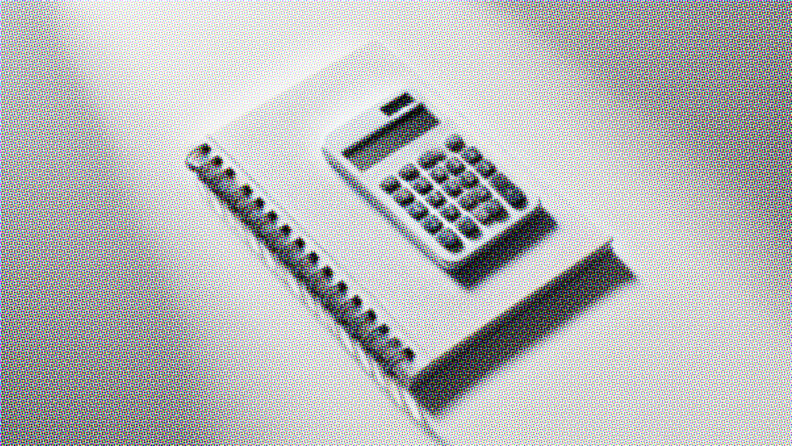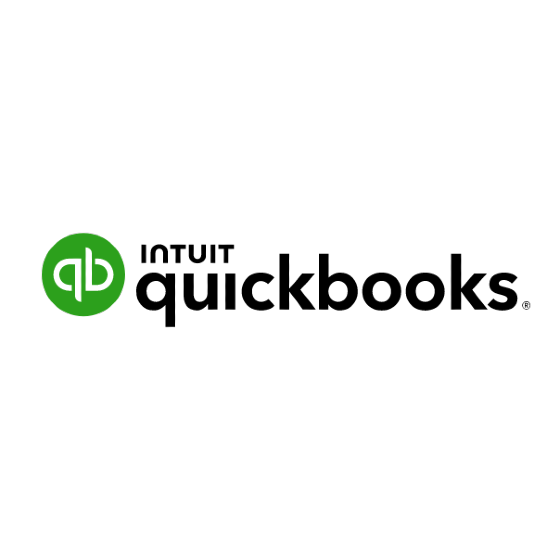A balance sheet gives a snapshot of a company's financial position, showing assets, liabilities, and shareholder's equity at a specific moment, providing crucial insights into fiscal health.
Making a balance sheet involves listing and categorizing your assets, liabilities, and equity with precision. A clear structure helps ensure everything adds up and makes sense to stakeholders.
If your balance sheet doesn’t balance, it’s usually due to a missing entry, misclassification, or calculation error. Double-check your figures step by step to find where things went off track.
Making a balance sheet involves categorizing all accounts with a debit or credit balance and presenting those categories in a predefined format.
As a former accountant, I’ve created my fair share of balance sheets over the years. Sure, now accounting software can whip one up in seconds, but it’s still handy to know how to build one yourself, in case technology ever fails.
In this guide, I’ll walk you through the process step by step. You’ll learn how to sort your assets, liabilities, and equity into the right categories, format everything correctly, and end up with a tidy little financial snapshot. Let's dive in.
What Is A Balance Sheet?
A balance sheet is a financial statement that provides a snapshot of a company's financial position at a specific point in time.
It outlines the company's assets, liabilities, and shareholders' equity, following the formula:
Assets = Liabilities + Shareholders' Equity
This equation ensures that what the company owns (assets) is balanced by what it owes (liabilities) and the value provided by shareholders (equity). Here's what each category includes:
Assets
Assets represent what a company owns or controls that have economic value. These are typically divided into:
- Current assets (e.g., cash, accounts receivable, inventory) that can be converted into cash within a year, and
- Non-current assets (e.g., property, equipment, patents), which are long-term investments.
Assets are essential for generating future revenue.
Liabilities
Liabilities are the company’s obligations or debts that need to be settled, often in the form of money owed to others. Like assets, liabilities are categorized as:
- Current liabilities (e.g., accounts payable, short-term debt) due within a year, and
- Non-current liabilities (e.g., long-term loans, deferred tax liabilities) payable beyond a year.
Shareholders' Equity
Shareholders' equity represents the owners' claim on the company's assets after all liabilities are paid off. It includes common stock, retained earnings, and additional paid-in capital.
Essentially, it reflects the net worth of the company from the shareholders' perspective, often used to assess the financial health and investment potential of the business.
-

Workday Adaptive Planning
Visit WebsiteThis is an aggregated rating for this tool including ratings from Crozdesk users and ratings from other sites.4.4 -

Rippling Spend
Visit WebsiteThis is an aggregated rating for this tool including ratings from Crozdesk users and ratings from other sites.4.8 -

QuickBooks Online
Visit WebsiteThis is an aggregated rating for this tool including ratings from Crozdesk users and ratings from other sites.4
Why Do You Need A Balance Sheet?
Before you create a balance sheet for your business, let’s talk about why you need one in the first place. Here’s a quick overview of the reasons to prepare this statement:
- Keep tabs on fiscal fitness: The balance sheet tells you what your business owns and owes, and what’s left over for equity shareholders.
- Make smarter decisions: It helps management make smarter decisions when planning expansion and raising capital. It also helps when it comes time to forecast.
- Give investors a peek into your business: Investors decide if they want to invest in a company based on factors like the level of debt and age/quality of assets.
How to Make a Balance Sheet in 6 Steps
While most companies use accounting software to create real-time balance sheets, learning to prepare it manually is a great way to truly understand how it works and where all the numbers come from.
As I explain how to make a balance sheet below, I’ll use Apple’s as an example. But if you're looking for a quick summary, here's an infographic outlining the crucial steps:
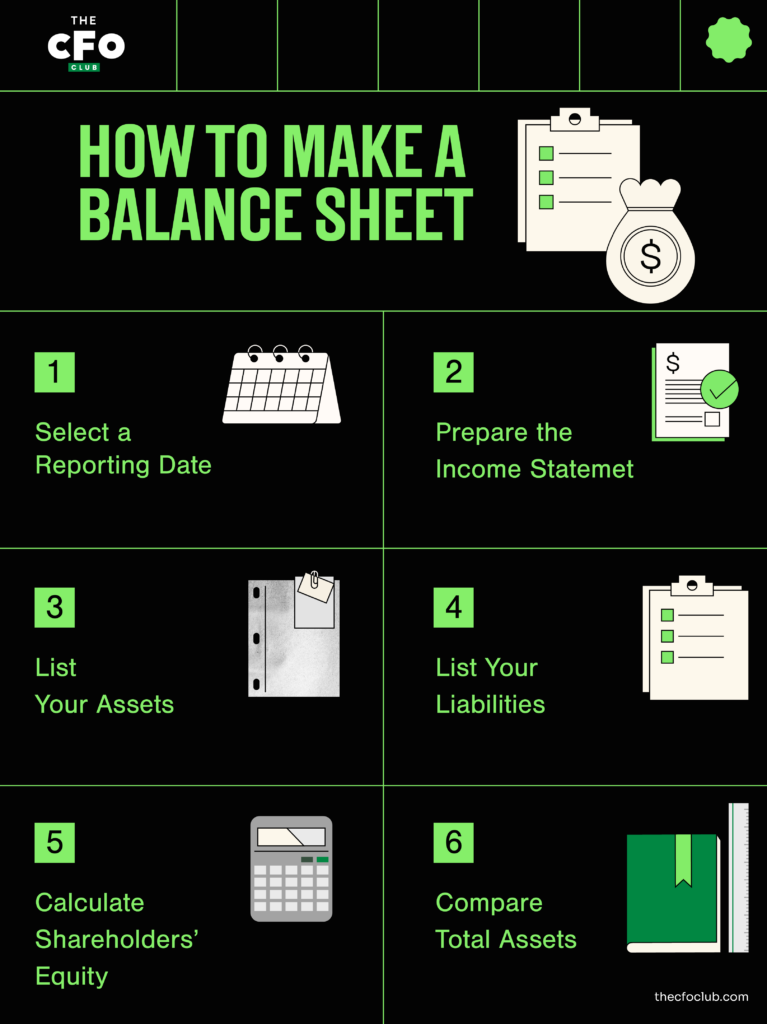
1. Select a Reporting Date
Balance sheets are prepared at a specific point in time, unlike an income statement, which shows the company’s performance over a defined period. The balance sheet is a statement that shows the balances of all accounts in your books, and since account balances change with every business transaction, the balance sheet may look different after every transaction.
Corporations like Apple generally choose the end of the financial reporting period as the date of the balance sheet:
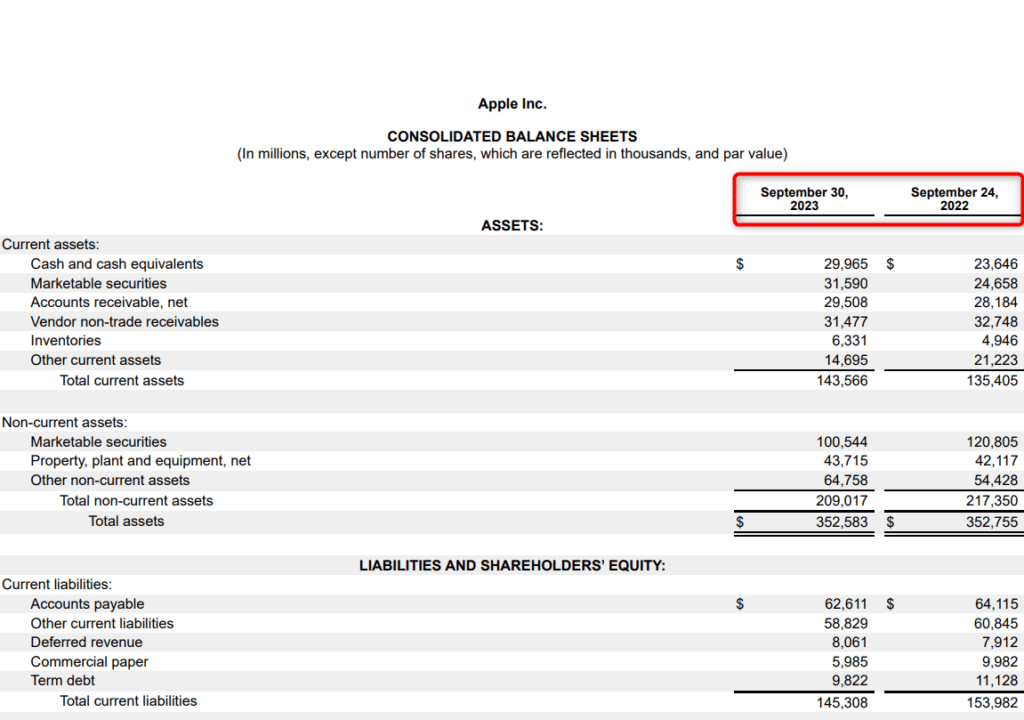
You don’t necessarily have to wait until the end of the accounting cycle to prepare a balance sheet. While most companies prepare their balance sheet when closing their books each month, quarter, or year, you can choose to prepare a balance sheet any time you want to conduct analysis.
For example, if you’re about to acquire a company, you’ll need an updated balance sheet to understand how the acquisition will impact you in the immediate term.
2. Prepare the Income Statement and Statement of Retained Earnings
When getting your financial statements in order, the balance sheet is prepared last.
Every year, your business (hopefully) makes a profit. If not distributed as dividends, profit ends up in the equity shareholders’ accounts as retained earnings.
This increases the amount reported under the stockholders’ equity section of the balance sheet, which is why you need to prepare the income statement and statement of retained earnings before you start preparing your balance sheet.
If we back up even further, we find that the income statement helps calculate the net income, which helps prepare the statement of retained earnings, which then leads back here.
3. List Your Assets
Once you have all the figures you need, the first order of business is to list your company’s assets. Here’s how Apple presents assets on its balance sheet:
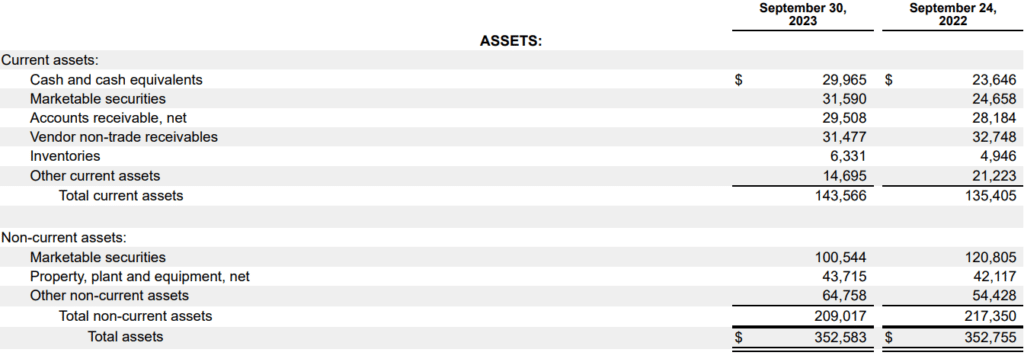
Assets are listed on the balance sheet in order of liquidity, with the most highly liquid assets listed first. As a reminder, assets are categorized as current and non-current:
- Current assets: Current assets a company can convert into cash in the short term (within a year or one operating cycle). For example, cash, cash equivalents (marketable securities, commercial instruments, or other money market instruments), inventory, and accounts receivable.
- Non-current assets: Non-current assets are long-term assets. They’re categorized into fixed (or tangible) assets and intangible assets. Fixed assets—including land, buildings, and depreciable assets such as equipment and vehicles—are recorded at book value, net of depreciation. Intangible assets like goodwill appear at last, because they can only be converted into cash when you sell your business.
4. List Your Liabilities
After you’ve added all your assets, it’s time to add your business’s liabilities to the balance sheet. Here's a look at how Apple outlines their liabilities:

Keep in mind that liabilities are also generally categorized as current and non-current:
- Current liabilities: Current liabilities are debts a company must pay within one operating cycle (again, typically one year or less). Accounts payable, short-term debt, and unpaid dividends are examples of current liabilities.
- Non-current liabilities: Non-current liabilities are long-term debts (that aren’t due within the next 12 months). Long-term liabilities include bonds payable, pension benefit obligations, and deferred tax liabilities.
5. Calculate Shareholders’ Equity
Owner’s equity (or shareholders’ equity) is the difference between total assets and total liabilities:
Shareholders’ Equity = Total Assets - Total Liabilities
Another way to calculate the shareholders’ equity is by adding the balance in the retained earnings and common stock accounts.
Bigger companies like Apple may have additional line items—for example, preferred stock and accumulated comprehensive income. If you’re not in a large corporation, you don’t need to worry about these.

The shareholders’ equity section of the balance sheet represents the company’s theoretical net worth: It’s the amount that the business owners would be left with after selling all assets and paying liabilities. However, I say it’s theoretical because the market value of an asset is almost always different from the book value.
6. Compare Total Assets with Total Liabilities Plus Owner’s Equity
The assets must be equal to the total liabilities plus shareholders’ equity—hence the term “balance” sheet. If the figures match and everything looks good, then your balance sheet is correct. If it doesn’t match, there are a few common reasons it may be off, including:
- Omitted or inaccurately recorded transactions
- Inaccurately recorded amortization or depreciation expenses
- Errors in converting currency exchange rates
- Incorrect calculation of shareholders’ equity
When to Make a Balance Sheet
Companies typically prepare a balance sheet at the end of each accounting period. This can be monthly, quarterly, or annually. However, you don’t necessarily need to wait for the end of an accounting period to prepare a balance sheet.
Small business accounting software gives you a real-time view of your balance sheet by updating it with every transaction you record.
A real-time view is helpful because it helps you assess your business’s financial health. This helps you make smarter decisions regarding various aspects of business, such as a change in credit policy or how much capital the company should raise (and when). Plus, it saves you from having to look up how to make a balance sheet every quarter.
-

BlackLine
Visit WebsiteThis is an aggregated rating for this tool including ratings from Crozdesk users and ratings from other sites.4.5 -

Xledger
Visit WebsiteThis is an aggregated rating for this tool including ratings from Crozdesk users and ratings from other sites.4.5 -

FreshBooks
Visit WebsiteThis is an aggregated rating for this tool including ratings from Crozdesk users and ratings from other sites.4.5
Balance Sheet Example & Analysis
You have a balance sheet, so what’s next?
Experienced accountants can pretty much eyeball the statement and get a sense of the company’s financial position, but you shouldn’t try to hold yourself to that standard just yet.
If you’re just preparing your first balance sheet, you can use financial metrics like the current ratio and debt-to-equity ratio to assess your company’s balance sheet.
Let’s use a simplified version as an example to understand how you can assess it:
| Assets | Amount ($) | |
| Current Assets | $100,000 | |
| Non-Current Assets | $300,000 | |
| Total | $400,000 | |
| Liabilities and Shareholder’s Equity | ||
| Current Liabilities | $50,000 | |
| Non-Current Liabilities | $250,000 | |
| Stockholders’ Equity | $100,000 | |
| Total | $400,000 | |
Here are some quick insights we can draw from this example:
- Positive working capital: The company has a positive working capital of $50,000. Working capital is calculated by subtracting current liabilities from current assets.
- Debt-to-equity (D/E) ratio: The D/E ratio tells you how much of your capital comes from debt versus equity—in the example above, the D/E ratio is 3. It’s calculated by dividing total liabilities by shareholders’ equity. There’s no single D/E ratio that’s good or bad, but you can refer to industry averages to see how you stack up.
- Current ratio: Quick ratio is a liquidity ratio that shows your company’s capacity to pay short-term obligations within a year. In our example, the current ratio is 2. It’s calculated by dividing the total of cash, cash equivalents, and marketable securities by total current liabilities.
There are three of the many balance sheet ratios you can use to analyze how a company is doing.
Common Mistakes to Avoid When Making a Balance Sheet
Outside from the potential errors listed above, there are a few other mistakes you can make when making a balance sheet:
Double Counting Assets
It's easy to mistakenly record the same asset in multiple places—like listing a piece of equipment both as an individual asset and within a broader category. This inflates your asset totals and can mislead stakeholders.
Misclassifying Liabilities
Classifying liabilities incorrectly, such as recording a long-term loan as a current liability, can distort liquidity ratios and give an inaccurate picture of how well your company can meet short-term obligations.
Ignoring Owner's Equity Adjustments
Owner’s equity isn’t a “set-it-and-forget-it” number—it changes with every net income, loss, dividend, or owner draw. If you forget to update it, your balance sheet will be off even if assets and liabilities are accurate.
Make Smart Financial Decisions With Your Balance Sheet
Learning how to make a balance sheet helps keep all your stakeholders — management, investors, and lenders — informed, and helps make informed decisions about the business.
Management may look at the balance sheet to manage working capital or leverage. Investors may use it to analyze the asset portfolio and capital structure. Lenders may look at whether your balance sheet has some more room for debt capital without causing any financial discomfort on your balance sheet, income statement, or cash flow statement.
Want to learn more about financial statements and other financial concepts? Subscribe to our free newsletter for expert advice, tips, and insights from finance leaders.

